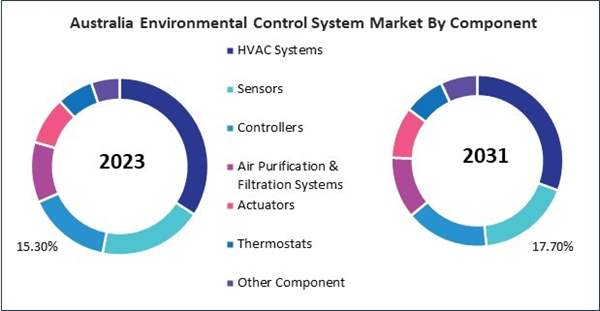The China market dominated the Asia Pacific Environmental Control System Market by country in 2023, and is expected to continue to be a dominant market till 2031; thereby, achieving a market value of $564.9 million by 2031. The Japan market is showcasing a CAGR of 6.1% during 2024-2031. Additionally, the India market would register a CAGR of 7.6% during 2024-2031.
An Environmental Control System (ECS) is a complex, integrated system designed to regulate and maintain optimal environmental conditions within enclosed spaces, ensuring the comfort, safety, and functionality of occupants and sensitive equipment. ECS is commonly used in aircraft, spacecraft, submarines, military vehicles, and specialized industrial environments where precise control of temperature, humidity, air pressure, and air quality are essential.
Additionally, the environmental control system market has emerged as a critical segment within the broader aerospace and defense industries, playing a vital role in ensuring the safety, comfort, and operational efficiency of various platforms. The market has experienced substantial growth and innovation as the demand for more sustainable, reliable, and efficient systems increases and technology continues to advance.
Japan's market is significantly influenced by its extensive marine industry. The country's dedication to reducing greenhouse gas emissions is demonstrated by its decision to reduce emissions by 60% by fiscal year 2035 in comparison to 2013 levels. This target has been incorporated into the updated Nationally Determined Contribution under the Paris Agreement. This ambitious goal has led to increased deployment of emission control systems across various sectors, including maritime operations. The government's support for research and development in green technologies further propels the market, fostering innovation and the integration of cutting-edge solutions in marine vessels to meet these stringent environmental standards.
List of Key Companies Profiled
- Honeywell International Inc.
- Siemens AG
- Thermo Fisher Scientific, Inc.
- Danaher Corporation
- 3M Company
- Liebherr-International AG
- Parker Hannifin Corporation
- Curtiss-Wright Corporation
- Merck KGaA
- Schneider Electric SE
Market Report Segmentation
By Product
- Water Treatment Systems
- Air Quality Control Systems
- Waste Management Systems
- Energy Management Systems & Other
By Component
- HVAC Systems
- Sensors
- Controllers
- Air Purification & Filtration Systems
- Actuators
- Thermostats
- Other Component
By End Use
- Manufacturing
- Healthcare
- Automotive
- Aerospace
- Agriculture
- Marine
- Other End Use
By Country
- China
- Japan
- India
- South Korea
- Australia
- Malaysia
- Rest of Asia Pacific
Table of Contents
Companies Mentioned
- Honeywell International Inc.
- Siemens AG
- Thermo Fisher Scientific, Inc.
- Danaher Corporation
- 3M Company
- Liebherr-International AG
- Parker Hannifin Corporation
- Curtiss-Wright Corporation
- Merck KGaA
- Schneider Electric SE
Methodology

LOADING...









